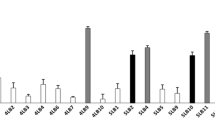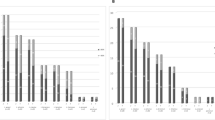Abstract
Vaginal lactobacilli protect against bacterial vaginosis and vaginal candidiasis. They may have probiotic properties and help maintain the balance and health of the vaginal ecosystem while the loss of these bacteria predisposes females to urinary and genital infections. The aim of this study was to investigate the probiotic potential of vaginal Lactobacillus among healthy females in northern Iran. The Lactobacillus strains were isolated from vaginal samples and were identified by sequencing of the 16S rRNA fragment. Functional properties such as tolerance to low pH, H2O2 production, adherence ability to Hela cells and antagonistic activity against Candida albicans was examined. A total of 38 vaginal lactobacilli strains from five species, including Lactobacillus crispatus (n = 13), Lactobacillus gasseri (n = 10), Lactobacillus acidophilus (n = 6), Lactobacillus jensenii (n = 5) and Lactobacillus johnsonii (n = 4), were identified. All of the species showed significant tolerance to low pH over 24 h (p < 0.001). The best adherence ability to Hela cells was seen in Lactobacillus gasseri strains. Nearly 17 of the strains had higher anti-candida activity compared to the other strains. According to the findings, four lactobacilli strains isolated in the vaginal samples of healthy Iranian women had the best probiotic potential.




Similar content being viewed by others
Availability of Data and Materials
Not applicable.
Code Availability
Not applicable.
References
Nami Y et al (2014) Assessment of probiotic potential and anticancer activity of newly isolated vaginal bacterium Lactobacillus plantarum 5BL. Microbiol Immunol 58:492–502. https://doi.org/10.1111/1348-0421.12175
Srinivasan S, Fredricks DN (2008) The human vaginal bacterial biota and bacterial vaginosis. Interdiscip Perspect Infect Dis. https://doi.org/10.1155/2008/750479
Ahmadi M et al (2017) Analysis of cervical lesions for presence of HSV-2 and HPV-16 and HPV-18 in Iranian patients by PCR. Horm Mol Biol Clin Investig 31:20170019. https://doi.org/10.1515/hmbci-2017-0019
Chee WJY, Chew SY, Than LTL (2020) Vaginal microbiota and the potential of Lactobacillus derivatives in maintaining vaginal health. Microb Cell Fact 19:203. https://doi.org/10.1186/s12934-020-01464-4
Santos CM et al (2016) Selection of Lactobacillus strains as potential probiotics for vaginitis treatment. Microbiology 162:1195–1207. https://doi.org/10.1099/mic.0.000302
Borges S, Silva J, Teixeira P (2014) The role of lactobacilli and probiotics in maintaining vaginal health. Arch Gynecol Obstet 289:479–489. https://doi.org/10.1007/s00404-013-3064-9
Petrova MI et al (2015) Lactobacillus species as biomarkers and agents that can promote various aspects of vaginal health. Front Physiol 6:81. https://doi.org/10.3389/fphys.2015.00081
Kligler B, Cohrssen A (2008) Probiotics. Am Fam Phys 78:1073–1078
Witkin SS, Linhares IM (2017) Why do lactobacilli dominate the human vaginal microbiota? BJOG Int J Obstet Gynaecol 124:606–611. https://doi.org/10.1111/1471-0528.14390
Champer M et al (2018) The role of the vaginal microbiome in gynaecological cancer. BJOG Int J Obstet Gynaecol 125:309–315. https://doi.org/10.1111/1471-0528.14631
Motevaseli E, Dianatpour A, Ghafouri-Fard S (2017) The role of probiotics in cancer treatment: emphasis on their in vivo and in vitro anti-metastatic effects. Int J Mol Cell Med 6:66. https://doi.org/10.22088/acadpub.BUMS.6.2.1
Richardson MD (2005) Changing patterns and trends in systemic fungal infections. J Antimicrob Chemother 56:i5–i11. https://doi.org/10.1093/jac/dki218
Chen X et al (2007) The S-layer proteins of Lactobacillus crispatus strain ZJ001 is responsible for competitive exclusion against Escherichia coli O157: H7 and Salmonella typhimurium. Int J Food Microbiol 115:307–312. https://doi.org/10.1016/j.ijfoodmicro.2006.11.007
Chen C-C, Walker WA (2005) Probiotics and prebiotics: role in clinical disease states. Adv Pediatr 52:77–113. https://doi.org/10.1016/j.yapd.2005.03.001
Dubernet S, Desmasures N, Guéguen M (2002) A PCR-based method for identification of lactobacilli at the genus level. FEMS Microbiol Lett 214:271–275. https://doi.org/10.1111/j.1574-6968.2002.tb11358.x
Gu XC et al (2014) Cloning and analysis of bile salt hydrolase genes from Lactobacillus plantarum CGMCC No. 8198. Biotechnol Lett 36:975–983. https://doi.org/10.1007/s10529-013-1434-9
Corzo G, Gilliland S (1999) Bile salt hydrolase activity of three strains of Lactobacillus acidophilus. J Dairy Sci 82:472–480. https://doi.org/10.3168/jds.S0022-0302(99)75256-2
Khalil R et al (2007) Evaluation of the probiotic potential of lactic acid bacteria isolated from faeces of breast-fed infants in Egypt. Afr J Biotechnol 6:939–949
Al Kassaa I et al (2014) Identification of vaginal lactobacilli with potential probiotic properties isolated from women in North Lebanon. Microb Ecol 67:722–734. https://doi.org/10.1007/s00248-014-0384-7
Pino A et al (2019) Detection of vaginal lactobacilli as probiotic candidates. Sci Rep 9:3355. https://doi.org/10.1038/s41598-019-40304-3
Eschenbach DA et al (1989) Prevalence of hydrogen peroxide-producing Lactobacillus species in normal women and women with bacterial vaginosis. J Clin Microbiol 27:251–256. https://doi.org/10.1128/jcm.27.2.251-256.1989
Hütt P et al (2016) Characterisation of probiotic properties in human vaginal lactobacilli strains. Microb Ecol Health Dis 27:30484. https://doi.org/10.3402/mehd.v27.30484
Mousavi E et al (2016) In vitro adherence of Lactobacillus strains isolated from the vaginas of healthy Iranian women. J Chin Med Assoc 79:665–671. https://doi.org/10.1016/j.jcma.2016.04.007
Martínez-Peña MD, Castro-Escarpulli G, Aguilera-Arreola MG (2013) Lactobacillus species isolated from vaginal secretions of healthy and bacterial vaginosis-intermediate Mexican women: a prospective study. BMC Infect Dis 13:1–9. https://doi.org/10.1186/1471-2334-13-189
Vitali B et al (2007) Dynamics of vaginal bacterial communities in women developing bacterial vaginosis, candidiasis, or no infection, analyzed by PCR-denaturing gradient gel electrophoresis and real-time PCR. Appl Environ Microbiol 73:5731–5741. https://doi.org/10.1128/AEM.01251-07
Nami Y, Haghshenas B, Khosroushahi AY (2018) Molecular identification and probiotic potential characterization of lactic acid bacteria isolated from human vaginal microbiota. Adv Pharm Bull 8:683. https://doi.org/10.15171/apb.2018.077
Gupta S, Kakkar V, Bhushan I (2019) Crosstalk between vaginal microbiome and female health: a review. Microb Pathog 136:103696. https://doi.org/10.1016/j.micpath.2019.103696
Organization WH (2006) Food and Agriculture Organization of the United Nations. Probiotics in food. Health and nutritional properties and guidelines for evaluation. FAO Food Nutr Pap 85:2
Kiray E, Kariptas E, Azarkan SY (2019) Evaluation of vaginal lactobacilli with potential probiotic properties and biotherapeutic effects isolated from healthy Turkish women. PSM Microbiol 4:56–70
Nami Y et al (2014) Probiotic potential and biotherapeutic effects of newly isolated vaginal Lactobacillus acidophilus 36YL strain on cancer cells. Anaerobe 28:29–36. https://doi.org/10.1016/j.anaerobe.2014.04.012
Gu X-C et al (2014) Cloning and analysis of bile salt hydrolase genes from Lactobacillus plantarum CGMCC No. 8198. Biotechnol Lett 36:975–983. https://doi.org/10.1007/s10529-013-1434-9
Starling S (2013) Global probiotics market to grow 6.8% annually until 2018
Dover S et al (2008) Natural antimicrobials and their role in vaginal health: a short review. Int J Probiotics Prebiotics 3:219
Reid G, Dols J, Miller W (2009) Targeting the vaginal microbiota with probiotics as a means to counteract infections. Curr Opin Clin Nutr Metab Care 12:583–587. https://doi.org/10.1097/MCO.0b013e328331b611
Otero MC, Nader-Macías ME (2007) Lactobacillus adhesion to epithelial cells from bovine vagina. Commun Curr Res Educ Top Trends Appl Microbiol 20007:749–757
Kumherová M et al (2021) Novel potential probiotic Lactobacilli for prevention and treatment of vulvovaginal infections. Probiotics Antimicrob Proteins 13:163–172. https://doi.org/10.1007/s12602-020-09675-2
Sengupta R et al (2013) The role of cell surface architecture of lactobacilli in host-microbe interactions in the gastrointestinal tract. Mediat Inflamm. https://doi.org/10.1155/2013/237921
Vladareanu R et al (2018) New evidence on oral L. plantarum P17630 product in women with history of recurrent vulvovaginal candidiasis (RVVC): a randomized double-blind placebo-controlled study. Eur Rev Med Pharmacol Sci 22:262–267
Kinoshita H et al (2008) Cell surface Lactobacillus plantarum LA 318 glyceraldehyde-3-phosphate dehydrogenase (GAPDH) adheres to human colonic mucin. J Appl Microbiol 104:1667–1674. https://doi.org/10.1111/j.1365-2672.2007.03679.x
Acknowledgements
Authors would like to thank staff of Amol Pasture Institute.
Funding
Not applicable.
Author information
Authors and Affiliations
Contributions
All authors contributed to the study conception and design and experiments. Material preparation, performed experiments, data collection and analysis were performed by HZ, RIA, MR, HK. The first draft of the manuscript was written by HZ. FZ Supervised, directed and managed the study. All authors read and approved the final manuscript.
Corresponding author
Ethics declarations
Conflict of interest
The authors declare that there are no conflict of interest.
Ethical Approval
The study protocol was approved by the Ethics Committee of Amol Azad University (ID: IR.IAU.AMOL.REC.1400.051). At the beginning, all study participants were given adequate information about the study. Then informed consent was obtained.
Consent to Participate
The procedure was explained to all the recruited participate who signed written informed consent forms.
Consent for Publication
Not applicable.
Additional information
Publisher's Note
Springer Nature remains neutral with regard to jurisdictional claims in published maps and institutional affiliations.
Appendix
Appendix
See Table 5.
Rights and permissions
Springer Nature or its licensor (e.g. a society or other partner) holds exclusive rights to this article under a publishing agreement with the author(s) or other rightsholder(s); author self-archiving of the accepted manuscript version of this article is solely governed by the terms of such publishing agreement and applicable law.
About this article
Cite this article
Zare, H., Izadi Amoli, R., Rezapour, M. et al. Characterization of Vaginal Lactobacilli with Potential Probiotic Properties Isolated from Healthy Women in Northern Iran. Indian J Microbiol (2024). https://doi.org/10.1007/s12088-023-01186-2
Received:
Accepted:
Published:
DOI: https://doi.org/10.1007/s12088-023-01186-2




